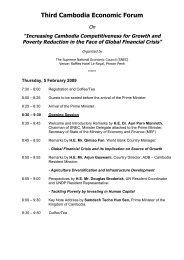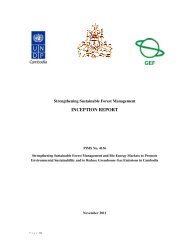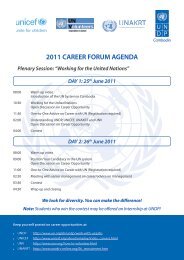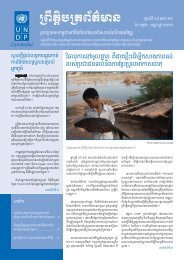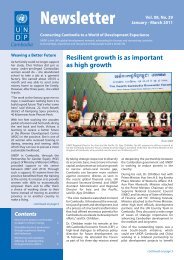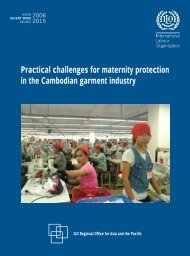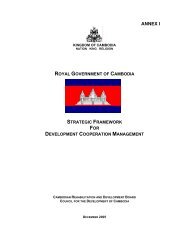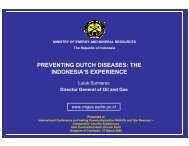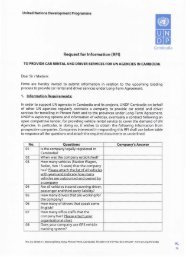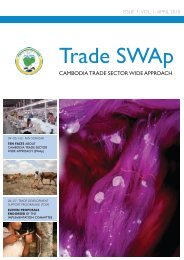UN Analysis Final.pdf - United Nations in Cambodia
UN Analysis Final.pdf - United Nations in Cambodia
UN Analysis Final.pdf - United Nations in Cambodia
You also want an ePaper? Increase the reach of your titles
YUMPU automatically turns print PDFs into web optimized ePapers that Google loves.
availability and strengthened delivery of quality reproductive and sexual health services; (iii) strengthened<br />
community awareness of reproductive and sexual health needs and rights and <strong>in</strong>creased demand for services;<br />
and (iv) an expanded evidence base to <strong>in</strong>form policy and strategy development.<br />
In September 2005, the National Authority for Combat<strong>in</strong>g Drugs (NACD) published the Five-Year National<br />
Plan on Drugs Control 2005-2010 (NPDC 2005-2010) (http://www.nacd.gov.kh). The Plan aims to m<strong>in</strong>imize<br />
drug-related harm to <strong>in</strong>dividuals, families and society. A structure for implementation, monitor<strong>in</strong>g and<br />
review<strong>in</strong>g this strategy is <strong>in</strong> place and <strong>in</strong>cludes opportunities for agencies and NGOs to work with the<br />
committees that oversee the strategy. NPDC 2005-2010 has identified youth as a ‘high risk’ group.<br />
In 2005, MoEYS, <strong>in</strong> collaboration with the National Centre for HIV/AIDS, Dermatology and STD (NCHADS)/<br />
MoH, established the Programme on Life Skills for HIV and AIDS Education. It targeted <strong>in</strong>- and out-of-school<br />
youth, and piloted its first phase <strong>in</strong> two prov<strong>in</strong>ces (Siem Reap and Kampong Speu), subsequently expand<strong>in</strong>g<br />
to 12 prov<strong>in</strong>ces <strong>in</strong> 2006/07. The Programme aimed to ma<strong>in</strong>stream and strengthen the life skills of primary<br />
students (Grades 5-6) and secondary students through classroom teach<strong>in</strong>g and a peer educator approach.<br />
Through the peer education-based approach, the Programme also targeted out-of-school youths aged<br />
13-19, <strong>in</strong>clud<strong>in</strong>g street children, especially <strong>in</strong> Phnom Penh. However, there has been little if any monitor<strong>in</strong>g<br />
or implementation data on these programmes and it is difficult to assess the reach, content or quality<br />
of what was be<strong>in</strong>g delivered to adolescents.<br />
The Second Expanded Basic Education Programme (EBEPII) 2006-2010 was <strong>in</strong>stituted <strong>in</strong> l<strong>in</strong>e with the<br />
M<strong>in</strong>istry’s strategic priorities outl<strong>in</strong>ed <strong>in</strong> the current Education Strategic Plan and the Education Sector<br />
Support Programme 2006-2010.. EBEPII ma<strong>in</strong>ly focuses on the <strong>in</strong>tegration of life skills associated with<br />
HIV and AIDS, drug abuse, early sexual <strong>in</strong>itiation and reproductive health <strong>in</strong>to the new curriculum. It will<br />
also <strong>in</strong>tegrate these life skills modules <strong>in</strong>to community-based vocational skills tra<strong>in</strong><strong>in</strong>g programmes<br />
with<strong>in</strong> the framework of local life skills <strong>in</strong> collaboration with MoLVT. EBEPII will advocate for the use of<br />
these materials by the MoEYS Youth Department <strong>in</strong> its regular outreach activities with out-of-school<br />
youths aged 10-24. Key objectives of the programme are implementation and prevention activities for<br />
both <strong>in</strong>- and out-of-school young people, with an emphasis on the development of positive attitudes<br />
and behaviour change, and the necessary <strong>in</strong>volvement of local communities.<br />
6.2 CURRENT SITUATION<br />
While there are no nationally available basel<strong>in</strong>e data about the health behaviour and status of young<br />
<strong>Cambodia</strong>ns, smaller surveys suggest that sexual and reproductive health issues, <strong>in</strong>clud<strong>in</strong>g sexually<br />
transmitted <strong>in</strong>fections and HIV and AIDS, unplanned pregnancy and unsafe abortion, are all areas of concern<br />
for adolescent/youth health. Other causes of morbidity and mortality <strong>in</strong>clude traffic accidents and<br />
<strong>in</strong>juries, drug abuse and gang violence. Negative lifestyle factors such as tobacco use, excessive alcohol<br />
consumption, drug abuse and poor use of leisure time underm<strong>in</strong>e the ability of youths to move towards<br />
<strong>in</strong>dependent and responsible adulthood and full participation <strong>in</strong> society (World Youth Report 2007).<br />
The major challenges to youth health <strong>in</strong>clude: sexual and reproductive health issues, <strong>in</strong>clud<strong>in</strong>g sexually<br />
transmitted <strong>in</strong>fections and HIV and AIDS, unwanted pregnancy, pregnancy-related illnesses and unsafe<br />
abortion; mental health (suicide); accidents, <strong>in</strong>clud<strong>in</strong>g drown<strong>in</strong>g, traffic accidents, falls, <strong>in</strong>juries from<br />
sharp objects and animal bites; and violence.<br />
66 Situation <strong>Analysis</strong> of Youth <strong>in</strong> <strong>Cambodia</strong>




